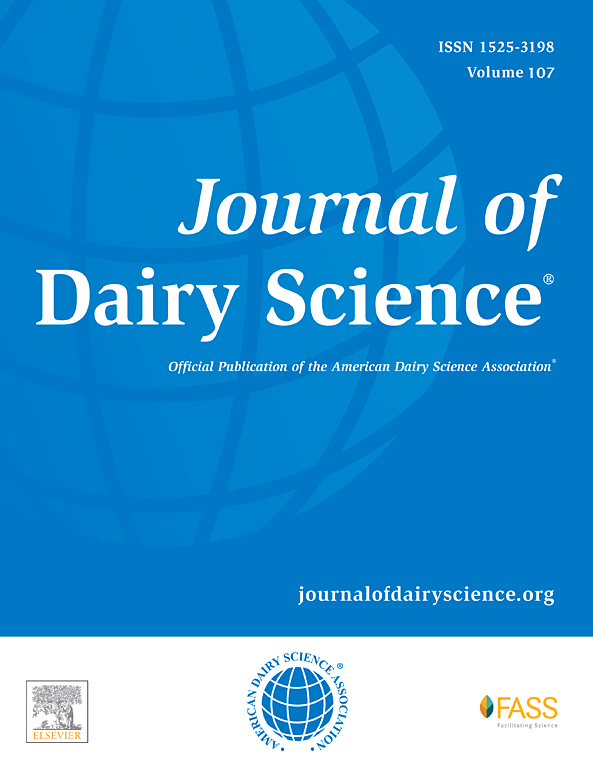中红外光谱可用于鉴定A2牛奶。
IF 4.4
1区 农林科学
Q1 AGRICULTURE, DAIRY & ANIMAL SCIENCE
引用次数: 0
摘要
由于β-酪蛋白的遗传变异,A2牛奶比普通牛奶更容易消化(A1);在肽链的第67位存在氨基酸脯氨酸而不是组氨酸,可防止在消化过程中释放β-酪啡肽-7。本研究评估了中红外(MIR)光谱作为一种快速、无创、常规的大规模方法来鉴定荷斯坦奶牛牛奶中A2变异的应用。从位于同一地区的饲养A1和A2奶牛的6个农场的1356头动物中提取了来自连续2个常规牛奶对照的2270份牛奶样本的光谱、遗传和牛奶质量(脂肪、蛋白质、乳糖和SCC)数据。遗传信息包括β-酪蛋白、κ-酪蛋白和β-乳球蛋白变体。在光谱建模之前,对牛奶成分差异进行统计评估。然后,对光谱信息进行初步的主成分分析(PCA),然后以30%的样品为测试集进行偏最小二乘判别分析(PLS-DA)。结果表明,各蛋白质组分的牛奶品质基本一致,但各养殖场之间差异不大(P < 0.05)。初步的光谱评估显示,PCA的前2个分量解释了73.2%的方差。然而,基于β-酪蛋白的遗传信息,它不能区分A1和A2牛奶样品。PLS-DA模型在A1A1基因型的训练和测试集中显示出最低的平衡准确性(50%)。对于基因型A1A2和A2A2,在训练集中记录的平衡准确性比在测试集中记录的更好,并且A2A2略高于A1A1。对于A1A2,训练集的平衡准确率为80%,测试集的平衡准确率为81%。对于A2A2,训练集的平衡准确率为81%,测试集的平衡准确率为82%。此外,仅考虑A1牛奶(基因型为A1A1和A1A2)和A2牛奶(基因型为A2A2)两种水平时,平衡准确率有所提高,训练集达到94%,测试集达到88%。综上所述,MIR光谱信息是一种基于PLS-DA模型的A2牛奶鉴别方法。本文章由计算机程序翻译,如有差异,请以英文原文为准。
Mid-infrared spectroscopy can be applied to authenticate A2 milk
Due to a genetic variation in β-casein, A2 milk is more easily digestible than regular milk (A1); presence of the amino acid proline instead of histidine in position 67 of the peptide chain prevents the release of β-casomorphin-7 during digestion. This study evaluated the application of mid-infrared (MIR) spectroscopy as a rapid, noninvasive, and routinely large-scale method to authenticate the A2 variant in Holstein cow milk. Spectral, genetic, and milk quality (fat, protein, lactose, and SCC) data from 2,270 milk samples from 2 consecutive routine milk controls were retrieved from 1,356 animals from 6 farms located in the same area that raised both A1 and A2 cows. Genetic information included β-casein, κ-casein, and β-lactoglobulin variants. Milk compositional differences were statistically assessed before the spectral modeling. Then, a preliminary principal component analysis (PCA) on spectra information was conducted, followed by a partial least squares discriminant analysis (PLS-DA) with 30% of the samples as the test set. Results indicated that milk quality was similar across all protein fractions but differed slightly among farms (P < 0.05). The preliminary spectral evaluation revealed that the first 2 components of the PCA explained 73.2% of the variance. Still, it could not segregate A1 and A2 milk samples based on β-casein genetic information. The PLS-DA model revealed the lowest balanced accuracy in the training and testing set for the genotype A1A1 (50%). For genotypes A1A2 and A2A2, a better balanced accuracy was recorded in the training than in the testing set and slightly greater for A2A2 than for A1A2. For A1A2, balanced accuracy was 80% for the training set and 81% for the testing set. For A2A2, the balanced accuracy was 81% for the training set and 82% for the testing set. Moreover, balanced accuracy improved when only considering 2 levels, A1 milk (comprising genotypes A1A1 and A1A2) and A2 milk (genotype A2A2), reaching 94% for the training set and 88% for the testing set. In conclusion, MIR spectral information is a promising method to authenticate A2 milk based on a PLS-DA model.
求助全文
通过发布文献求助,成功后即可免费获取论文全文。
去求助
来源期刊

Journal of Dairy Science
农林科学-奶制品与动物科学
CiteScore
7.90
自引率
17.10%
发文量
784
审稿时长
4.2 months
期刊介绍:
The official journal of the American Dairy Science Association®, Journal of Dairy Science® (JDS) is the leading peer-reviewed general dairy research journal in the world. JDS readers represent education, industry, and government agencies in more than 70 countries with interests in biochemistry, breeding, economics, engineering, environment, food science, genetics, microbiology, nutrition, pathology, physiology, processing, public health, quality assurance, and sanitation.
 求助内容:
求助内容: 应助结果提醒方式:
应助结果提醒方式:


